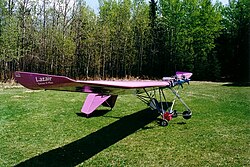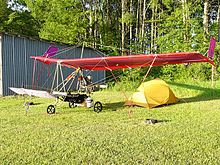






The Canadian Aviation Regulations define two types of ultralight aircraft: basic ultra-light aeroplane (BULA), and advanced ultra-light aeroplane (AULA).







The Canadian Aviation Regulations define two types of ultralight aircraft: basic ultra-light aeroplane (BULA), and advanced ultra-light aeroplane (AULA).
Regulation of ultra-light aircraft in Canada is covered by the Canadian Aviation Regulations. An earlier definition [1] of "ultra-light aeroplane", effective October 10, 1996, meant:
On June 1, 2003, the definition was amended to state that an "ultra-light aeroplane" means either an advanced ultra-light aeroplane or a basic ultra-light aeroplane. [2]
On July 6, 1956 the Department of Transport first issued new requirements for ultralight aircraft, a category that was eventually renamed "Amateur-built aircraft", leaving Canada without an ultralight category. The basic ultralight category was established as a new category in 1982 to fill this gap. [3] Regulation of ultralight aircraft in Canada is covered by the Canadian Aviation Regulations, which defines a "basic ultra-light aeroplane" as:
an aeroplane having no more than two seats, designed and manufactured to have:
According to Canadian Aviation Regulations, Part I, Subpart 1, an "advanced ultra-light aeroplane" means an aeroplane that has a type design that is in compliance with the standards specified in the manual entitled Design Standards for Advanced Ultra-light Aeroplanes (DS10141). [2] [4]
An advanced ultra-light aeroplane is an aeroplane which:
The advanced ultra-light aeroplane (AULA) category is similar, but not identical, to the American Light-Sport Aircraft (LSA) category. Many aircraft are available as AULAs in Canada and LSAs in the United States.
Advanced ultra-light aeroplanes shall have a minimum useful load, MU or WU computed as follows:
The maximum empty mass, MEmax, (WEmax) includes all operational equipment that is actually installed in the aeroplane. It includes the mass (weight) of the airframe, powerplant, required equipment, optional and specific equipment, fixed ballast, full engine coolant, hydraulic fluid, and the residual fuel and oil. Hence, the maximum empty mass (weight) = maximum take-off mass (weight) - minimum useful load. [5]
The registration marks for an advanced ultra-light aeroplane after 1997 begin with "C-Ixxx". Prior to that date they were C-Fxxx or C-Gxxx. [5]
An ultra-light pilot permit, recreational pilot permit, private, commercial or airline transport aeroplane licence issued by Transport Canada, is required in order for a person to operate an ultra-light aeroplane in Canada. [6] Pilots holding a Recreational or higher license may carry a passenger in a two-seat advanced ultra-light aeroplane. Pilots with only an ultra-light permit may not carry a passenger in an advanced ultralight unless they have received a passenger carrying endorsement. Basic ultralights cannot carry passengers unless the passenger is another pilot. Student pilots undergoing training may be carried in basic ultralights.
Canadian Basic and Advanced Ultralights may be flown in the USA if the pilot holds a Recreational Pilot Permit or higher designation. Pilots holding an Ultralight Pilot Permit with instructor rating and who have at least 2 hours of cross country experience may also fly to the US. [7]
Any Canadian Ultralight flying to the US also requires a Special Flight Operations Certificate from the FAA. This is a form the pilot completes which is then valid for 180 days. [8]
Officially this category of aircraft are known in Canada as Ultra-light Aeroplanes although in common use the American term Ultralight Airplanes is often used. [2]

Ultralight aviation is the flying of lightweight, 1- or 2-seat fixed-wing aircraft. Some countries differentiate between weight-shift control and conventional three-axis control aircraft with ailerons, elevator and rudder, calling the former "microlight" and the latter "ultralight".
The Aces High Cuby is a family of Canadian single engine, high wing, strut-braced, light sports planes with conventional landing gear that was marketed for homebuilding by Aces High Light Aircraft of London, Ontario.

Pilot licensing in Canada is administered by Transport Canada under the Aeronautics Act and the Canadian Aviation Regulations (CARs).

A light-sport aircraft (LSA), or light sport aircraft, is a fairly new category of small, lightweight aircraft that are simple to fly. LSAs tend to be heavier and more sophisticated than ultralight aircraft, but LSA restrictions on weight and performance separates the category from established GA aircraft. There is no standard worldwide description of an LSA.

An air taxi is a small commercial aircraft that makes short flights on demand.

The Progressive Aerodyne SeaRey is an American two-seat, single-engine, amphibious flying boat designed and manufactured by Progressive Aerodyne originally in Orlando, Florida, and now in Tavares, Florida. It was first flown in November 1992 and is sold as a kit aircraft for amateur construction as well as a light-sport aircraft.

The Blue Yonder EZ Harvard is a Canadian designed and built, single-engined, single-seat aircraft provided as a completed aircraft or in kit form by Blue Yonder Aviation. The aircraft is a 75% scale replica of the North American Harvard trainer of the Second World War.
The Blue Yonder EZ King Cobra is a Canadian designed and built, single-engined, single-seat aircraft provided as a completed aircraft or in kit form by Blue Yonder Aviation. The aircraft is approximately a 60% scale replica of the Second World War Bell P-63 Kingcobra fighter.

The Spectrum Beaver is a family of single- and two-place, pusher configuration, high-wing ultralight aircraft that were first introduced by Spectrum Aircraft of Surrey, British Columbia, Canada, in 1983.

The InterPlane Skyboy is a two-seat, side-by-side, high wing, single engine, pusher configuration ultralight aircraft that was manufactured as a completed aircraft by InterPlane Aircraft of Zbraslavice, Czech Republic.

The Murphy JDM-8 is a Canadian single-seat ultralight monoplane designed by Daryl Murphy. The type was intended to be sold as a kit for home construction by Murphy Aircraft of Chilliwack, British Columbia.
The Excalibur is an American two seats-in-tandem, high wing, pusher configuration ultralight aircraft that is manufactured in kit form for amateur construction, by Excalibur Aircraft of Sebring, Florida. It was introduced in 1993.

The Jabiru J170 is an Australian ultralight and light-sport aircraft, designed and produced by Jabiru Aircraft. The aircraft is supplied as a kit for amateur construction or as a complete ready-to-fly-aircraft.
The Norman Aviation Nordic 8 Mini Explorer is a Canadian ultralight aircraft, designed and produced by Norman Aviation of Saint-Anselme, Quebec. The aircraft is supplied as a kit for amateur construction.

The Rainbow Cheetah a South African ultralight and light-sport aircraft, designed by Vladimir Chechin and produced by Rainbow Aircraft. The aircraft is supplied as a kit for amateur construction or as a complete ready-to-fly-aircraft.
The Acrolite is a family of Canadian amateur-built aircraft, designed by Ron Wilson and produced by Acrolite Aircraft of Kakabeka Falls, Ontario, in the form of plans for amateur construction.

The Freedom Lite SS-11 Skywatch is a Canadian ultralight aircraft that was produced by Freedom Lite of Walton, Ontario and later by Legend Lite of New Hamburg, Ontario, introduced in 1996. When it was available the aircraft was supplied as a complete ready-to-fly-aircraft, or as a kit for amateur construction.
The Paxman Viper is a Canadian homebuilt aircraft that was designed by Elbert Paxman and produced by Paxman's Northern Aircraft of Glenwood, Alberta, introduced in 1994. When it was available the aircraft was supplied as a kit for amateur construction.
The Bilsam Sky Cruiser is a Polish microlight aircraft designed and produced by Bilsam Aviation of Poznań, introduced in the early 2000s. The aircraft is supplied as a complete ready-to-fly-aircraft, as a kit and in the form of plans for amateur construction.

The BDC Aero Puma is a Canadian ultralight and light-sport aircraft, originally designed by the Italian aircraft designer Antonio Bortolanza and built by Aeroplast of Sale, Piedmont, Italy. It is currently produced by BDC Aero Industrie of Lachute, Quebec. At one time available as a kit for amateur construction, now the aircraft is supplied only as a complete ready-to-fly-aircraft.
{{cite journal}}: Missing or empty |title= (help)